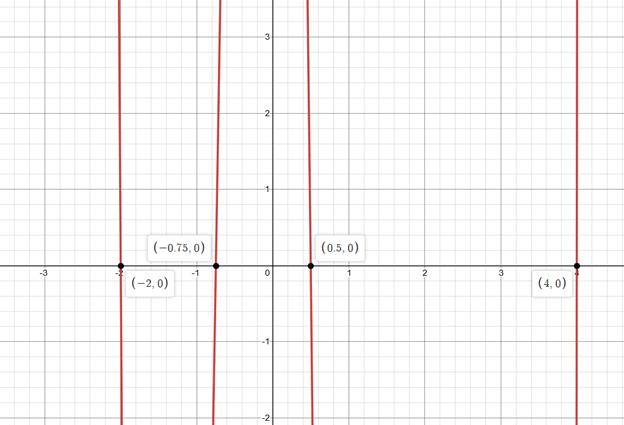
Concept explainers
a.
To verify whether
a.
Answer to Problem 56E
Factor
Explanation of Solution
Given:
Function:
Factor:
Calculation:
Verifying whether
Step 1: Writing coefficients of polynomial function on the right side and value of constant of factor with opposite sign on the left side.
Step 2: Now, adding terms in columns and multiplying the results by -2.
Here, the remainder is zero, it means that
Verifying whether
Step 1: Writing coefficients of polynomial function on the right side and value of constant of factor with opposite sign on the left side.
Step 2: Now, adding terms in columns and multiplying the results by 4.
Here, the remainder is zero, it means that
Conclusion:
Therefore,
b.
Find the remaining factors of the function
b.
Answer to Problem 56E
Explanation of Solution
Given:
Function:
Calculation:
Now, dividing above result with given function to find unfactored part.
Dividend:
Divisor:
So, quotient is
Hence,
Conclusion:
Therefore,
c.
Write the complete factorization of function
c.
Answer to Problem 56E
Explanation of Solution
Given:
Function:
Calculation:
From above answers, the complete factorization of given polynomial function is
Conclusion:
Therefore,
d.
Find the zeros of the function
d.
Answer to Problem 56E
Explanation of Solution
Given:
Function:
Calculation:
To find the zeros, put
Calculation for graph:
Consider
| Values of x | Values of f (x) |
| 0 | -40 |
| 1 | -63 |
| -1 | -15 |
| 2 | -264 |
| -2 | 0 |
By taking different values of x, the graph can be plotted.
Graph:

Interpretation:
By observing graph, it is clear that the curve of the function meets x-axis at
Hence, the zeros of the function are
Conclusion:
Therefore, the zeros of given polynomial function are
Chapter 2 Solutions
Precalculus with Limits: A Graphing Approach
- need help on Barrow_forward4. Use the properties of limits to help decide whether each limit exists. If a limit exists, fi lim (2x²-4x+5) a) x-4 b) lim 2 x²-16 x-4x+2x-8arrow_forward7. The concentration of a drug in a patient's bloodstream h hours after it was injected is given by 0.17 h Ah= h²+2' Find and interpret lim A(h). Remember, the answers to word problems should always be given in a complete h→00 sentence, with proper units, in the context of the problem.arrow_forward
- #2arrow_forward2. We want to find the inverse of f(x) = (x+3)² a. On the graph at right, sketch f(x). (Hint: use what you know about transformations!) (2 points) b. What domain should we choose to get only the part of f (x) that is one- to-one and non-decreasing? Give your answer in inequality notation. (2 points) - c. Now use algebra to find f¯¹ (x). (2 points) -4- 3- 2 1 -4 -3 -2 -1 0 1 -1- -2- --3- -4 -N- 2 3 4arrow_forward1. Suppose f(x) = 2 4 == x+3 and g(x) = ½-½. Find and fully simplify ƒ(g(x)). Be sure to show all x your work, write neatly so your work is easy to follow, and connect your expressions with equals signs. (4 points)arrow_forward
 Calculus: Early TranscendentalsCalculusISBN:9781285741550Author:James StewartPublisher:Cengage Learning
Calculus: Early TranscendentalsCalculusISBN:9781285741550Author:James StewartPublisher:Cengage Learning Thomas' Calculus (14th Edition)CalculusISBN:9780134438986Author:Joel R. Hass, Christopher E. Heil, Maurice D. WeirPublisher:PEARSON
Thomas' Calculus (14th Edition)CalculusISBN:9780134438986Author:Joel R. Hass, Christopher E. Heil, Maurice D. WeirPublisher:PEARSON Calculus: Early Transcendentals (3rd Edition)CalculusISBN:9780134763644Author:William L. Briggs, Lyle Cochran, Bernard Gillett, Eric SchulzPublisher:PEARSON
Calculus: Early Transcendentals (3rd Edition)CalculusISBN:9780134763644Author:William L. Briggs, Lyle Cochran, Bernard Gillett, Eric SchulzPublisher:PEARSON Calculus: Early TranscendentalsCalculusISBN:9781319050740Author:Jon Rogawski, Colin Adams, Robert FranzosaPublisher:W. H. Freeman
Calculus: Early TranscendentalsCalculusISBN:9781319050740Author:Jon Rogawski, Colin Adams, Robert FranzosaPublisher:W. H. Freeman
 Calculus: Early Transcendental FunctionsCalculusISBN:9781337552516Author:Ron Larson, Bruce H. EdwardsPublisher:Cengage Learning
Calculus: Early Transcendental FunctionsCalculusISBN:9781337552516Author:Ron Larson, Bruce H. EdwardsPublisher:Cengage Learning





